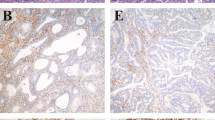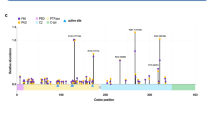Abstract
Mutator phenotype tumors provide unique opportunities to unravel malignant progression because of various gene alterations acquired during clonal tumor evolution. Gastric carcinomas, which have been known to show frequent genetic instability, would be composed of initial gene alterations shared by most tumor areas and subsequent alterations restricted to particular tumor sites. To analyse the timing of genetic events, we examined separate sites of tumor tissue obtained from a given gastric carcinoma patient with microsatellite instability (MSI). Our study included 95 normal/tumor area pairs from 25 patients. Six of the 25 patients (24%) demonstrated various levels of MSI ranging from 7% (two of 30) to 97% (28 of 29) of markers tested in multiple tumor sites. Of the six patients, five manifested frameshift mutations in a tract of ten deoxyadenosines within transforming growth factor β receptor type II and four demonstrated frameshift mutations in a tract of eight deoxyguanosines within BAX. These mutations were common to all tumor sites regardless of the various level of MSI phenotype, indicating initial events. Two of the six patients exhibited frameshift mutations in mononucleotide repeats of mismatch repair genes, hMSH3 and hMSH6, and the insulin-like growth factor II receptor in restricted tumor areas, indicating additional alterations. Insulin-like growth factor II receptor mutations appear to be caused by hMSH3 and hMSH6 mutations because the former mutations were confined to tumor portions with the latter two mismatch repair lesions. These results provide genetic progression evidence for gastric carcinomas of the mutator pathway. In this pathway, mismatch repair insufficiency initially targets mononucleotide tracts of transforming growth factor β receptor type II and BAX. During tumorigenesis, primary mismatch repair failure may give rise to the secondary mismatch repair lesions, frameshift mutations of hMSH3 and hMSH6, which result in another tumorigenic mutation in the insulin-like growth factor II receptor.
This is a preview of subscription content, access via your institution
Access options
Subscribe to this journal
Receive 50 print issues and online access
$259.00 per year
only $5.18 per issue
Buy this article
- Purchase on Springer Link
- Instant access to full article PDF
Prices may be subject to local taxes which are calculated during checkout
Similar content being viewed by others
Author information
Authors and Affiliations
Rights and permissions
About this article
Cite this article
Chung, YJ., Park, SW., Song, JM. et al. Evidence of genetic progression in human gastric carcinomas with microsatellite instability. Oncogene 15, 1719–1726 (1997). https://doi.org/10.1038/sj.onc.1201343
Received:
Revised:
Accepted:
Issue Date:
DOI: https://doi.org/10.1038/sj.onc.1201343
Keywords
This article is cited by
-
Helicobacter, Inflammation, and Gastric Cancer
Current Pathobiology Reports (2013)
-
Comparison of gene-expression profiles between diffuse- and intestinal-type gastric cancers using a genome-wide cDNA microarray
Oncogene (2004)
-
Prognostic Relevance of hMLH1, hMSH2, and BAX Protein Expression in Endometrial Carcinoma
Modern Pathology (2001)
-
Microsatellite Instability in the Adenoma-Carcinoma Sequence of the Stomach
Laboratory Investigation (2000)
-
Microsatellite instability, Epstein–Barr virus, mutation of type II transforming growth factor β receptor and BAX in gastric carcinomas in Hong Kong Chinese
British Journal of Cancer (1999)



